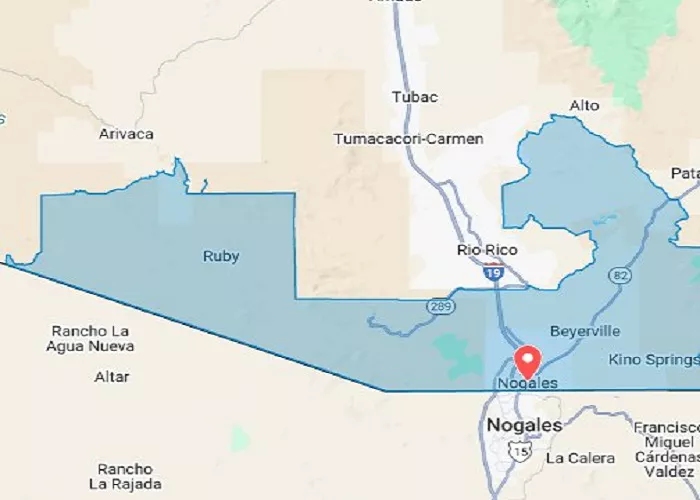Nogales, Arizona, is a unique border town with deep cultural and economic ties to Mexico. Many people ask, “Where is Nogales, Arizona on a map?” This article explores Nogales’ geographical location, cultural significance, economy, and ecology in detail. Whether you’re planning a visit, studying border towns, or just curious, this guide provides accurate and engaging information.
Geographical Location of Nogales, Arizona
Where Exactly Is Nogales?
Nogales is located in southern Arizona, right on the U.S.-Mexico border. It is part of Santa Cruz County and is directly connected to its sister city, Nogales, Sonora (Mexico).
- Coordinates: 31.3404° N latitude, 110.9342° W longitude
- Elevation: 3,865 feet (1,178 meters) above sea level
- Nearest Major City: Tucson, AZ (about 60 miles north)
- Distance from Phoenix: Approximately 175 miles (3-hour drive)
How to Find Nogales on a Map
To locate Nogales on an Arizona map:
- Find Tucson in the southern part of the state.
- Move south toward the Mexican border.
- Look for the town where Interstate 19 ends at the border crossing.
Nogales is Arizona’s primary border crossing into Sonora, Mexico, making it a key transit point.
Surrounding Landmarks
- Santa Cruz River – Flows through the city into Mexico.
- Patagonia Mountains – To the east, offering scenic views.
- Coronado National Forest – Nearby, with hiking trails.
- Tumacácori National Historical Park – A historic Spanish mission site.
Cultural Significance of Nogales
A Blend of American and Mexican Cultures
Nogales is a binational city, heavily influenced by Mexican culture:
- Language: Many residents are bilingual (Spanish & English).
- Food: Famous for authentic Mexican cuisine like street tacos and Sonoran hot dogs.
- Festivals: Celebrates both U.S. and Mexican holidays (Cinco de Mayo, Fourth of July).
Historical Background
- Founded in the 1880s as a railroad and mining town.
- Played a key role in Prohibition-era smuggling (alcohol crossed the border illegally).
- Today, it remains a major trade and immigration hub.
Modern-Day Nogales Culture
- Art & Music: Murals and mariachi bands are common.
- Border Dynamics: A mix of legal trade and challenges like immigration debates.
- Tourism: Many Americans visit for affordable dental/medical services in Mexico.
Economy of Nogales
Trade: The Backbone of Nogales
Nogales is one of the busiest border crossings in the U.S.:
- Fresh Produce Imports: Over $2 billion in fruits/vegetables pass through yearly (especially tomatoes, peppers, and cucumbers).
- Maquiladoras: Factories in Mexico send electronics and auto parts to the U.S.
- Customs & Logistics: Many jobs are tied to border security and shipping.
Tourism & Retail
- Day Trips to Mexico: Americans shop for crafts, medicine, and food.
- Dental/Medical Tourism: Affordable healthcare attracts visitors.
- Local Businesses: Restaurants, duty-free shops, and border services thrive.
Challenges in the Economy
- Dependence on Cross-Border Trade: Economic slowdowns in Mexico affect Nogales, AZ.
- Border Security Issues: Drug smuggling and immigration enforcement impact business.
- Seasonal Employment: Many jobs are tied to agriculture seasons.
Ecology and Environment of Nogales
Desert and Mountain Climate
Nogales has a semi-arid climate with mild winters and hot summers:
- Summer highs: 90–100°F (32–38°C)
- Winter lows: Rarely below freezing
- Monsoon season (July–Sept): Heavy rains cause flash floods.
Wildlife and Vegetation
- Plants: Mesquite, ocotillo, and saguaro cacti.
- Animals: Coyotes, javelinas, roadrunners, and rattlesnakes.
- Birdwatching: Hawks, eagles, and hummingbirds are common.
Environmental Challenges
- Water Scarcity: Relies on groundwater and the Santa Cruz River.
- Border Wall Impact: Wildlife migration is disrupted by fencing.
- Urban Expansion: Growth puts pressure on desert ecosystems.
Conclusion
Nogales, Arizona, is a vital border town with a rich cultural and economic history. Located just south of Tucson, it serves as a major gateway between the U.S. and Mexico. Its economy thrives on trade, tourism, and cross-border activities, while its ecology features rugged desert landscapes.
Now that you know where Nogales, Arizona is on a map, you can better understand its role in the Southwest. Whether you’re interested in border dynamics, Mexican culture, or desert ecology, Nogales offers a fascinating study.

